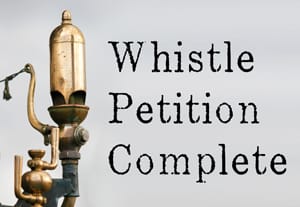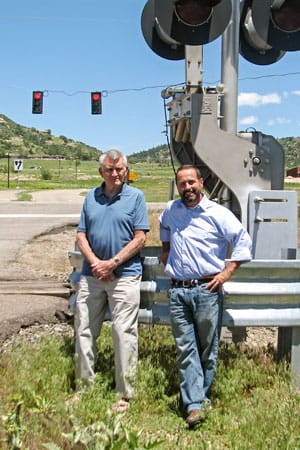Railroad quiet zone reaches completion

Article and photo by Elizabeth Wood West

Castle Pines Village resident Don Somsky (left) alongside Douglas County Engineer Sean Owens at one of the five crossings affected by the newly-enacted quiet zones.
Residents and business owners who live and/or work near the U.S. Highway 85 corridor between Sedalia and Atrium Drive have begun to experience less train horn noise and more peace and quiet, especially at night. The reason? A railroad quiet zone was recently established for the two public and five private railroad crossings in this area.
For more than four years, Castle Pines Village resident Don Somsky and other Village residents, the Castle Pines Homes Association (CPHA), the Castle Pines Metropolitan District (CPMD), and Douglas County (DC) have worked diligently with two railroad companies and both state and federal agencies to establish the quiet zone. The actual “silencing of train horns” went into effect on November 25.
The newly-established quiet zone is the result of a petition generated by Somsky and his neighbors which they presented to the Douglas County Commissioners. Somsky said, “Approximately 1,300 people signed the petition. The CPMD’s board of sirectors voted to give money to DC for the quiet zone. DC gave us an engineer to work with; we all worked together and the job is done! I think it shows if people stick together and fight together, they can get things done.”
DC engineer Sean Owens has worked on the quiet zone from the beginning. According to Owens, the quiet zone improvements include “no train horn” signs, warning signage, new stop signs, and new cross buck signs for both approaches at all five private crossings and the Manhardt Street/Highway 67 crossing. This is in addition to the existing medians, gates, bells, and lights conforming to quiet zone requirements previously installed by the Colorado Department of Transportation.
Atrium Drive now has wayside horns instead of regular train horn warnings. Owens explained, “Regular train horns are 105-120 decibels and directed in all directions; wayside horns are 100 decibels and directed at 90 degrees to the tracks at the ground, 100 feet away straight on, and 70-100 feet to the side. Wayside horns are set up for vehicles and pedestrians on the approaches to the crossing and the sound reduces faster as you move away from the crossing.”
Owens continued, “I have woken up every time the engineers have blown their horns irregularly during the night over the last three-to-four years and knew that I would get e-mails and phone calls in the morning asking when the quiet zone will be done. I look forward to sleeping through the night again and not having to ask some very upset folks to have patience with me and the process. I am sure it will take me a couple of nights to get used to the quiet, but I, like everyone else that has been involved, am looking forward to getting used to it,” he said. For further information, contact Sean Owens at 303-660-7328.